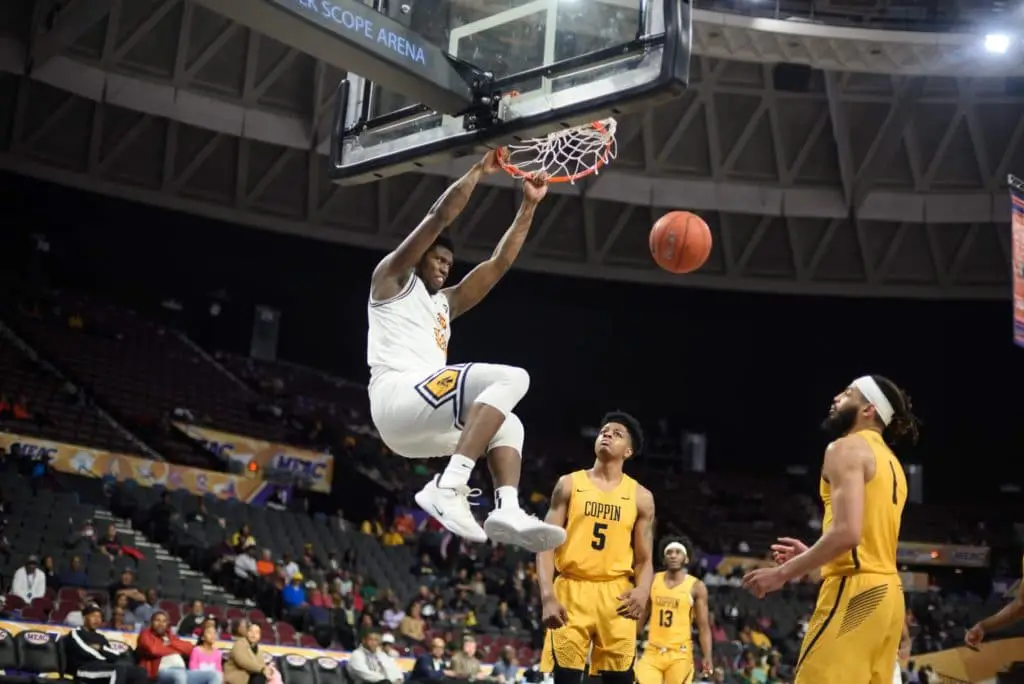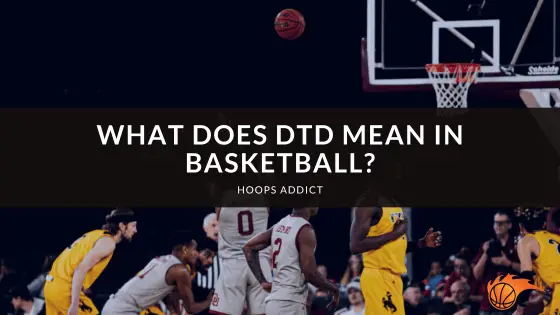Imagine being 6’6 and playing basketball on a rim that was only 7 feet. There would be no jumping, no dunking, and, overall, no fun. Would you want to watch a game that centered around abnormally tall men or women merely setting a ball in a hoop? Consider the heights of some of your favorite players.
Lebron James is 6 feet and 9 inches. Kevin Durant is 6 feet and 10 inches. Both men would practically be eye level with the intended goal. Therefore, the answer to these questions is simple. No, you wouldn’t.
The current NBA regulation hoop height is 10 feet. This is an essential characteristic of NBA basketball and one that many have questioned and scrutinized. With this article, we will not only provide you with the story behind the basket’s height; we will give you some information on the best height for children’s rims and so much more.
Keep reading to find out more about the NBA’s 10-foot hoop, how it came to be and why it has been and will be that way for years to come.
 What’s the Story Behind the 10-Foot Hoop?
What’s the Story Behind the 10-Foot Hoop?
You’re probably wondering where the idea of a 10-foot basketball hoop originated from. You probably might also be thinking that someone in the NBA is responsible for this critical aspect of basketball as we know it. Though it would be an excellent guess, you’d be wrong.
The NBA was founded in 1949, whereas basketball and the 10-foot hoop, has a history that spans slightly before this time. It is a little-known fact that the 10-foot hoop originated with the inventor of basketball. This inventor is James Naismith. Initially using a peach basket at a YMCA in Massachusetts, these baskets were initially hung on a running rack. This running rack happened to be 10 feet above the ground. Even after the peach baskets were replaced with iron hoops, they remained at the 10-foot height. James originally invented the game of basketball.
 Has NBA Hoop Height Ever Been Changed?
Has NBA Hoop Height Ever Been Changed?
The hoop height is one characteristic of the original basketball game that has been retained in the NBA throughout the years. With the onset of the National Basketball
Association in 1947, a players’ average height was 6’2. Though the height of the players has continuously grown, the basket remained at 10 feet.
There have been many critics of the hoop height, and several people argued that it should be changed. This change would ultimately be to keep the game more advanced and difficult for all players. This would especially be true, as A player’s average height is now 6’7.
Though there have been many arguments to change the height of the hoops, it has never been done. Even though the game may be a little easier for these inch advantaged players, there is no talk of making any changes to the height of the hoop anytime soon. Basketball as we know it is loved by all, and if it’s not broken, don’t try to fix it.
 Does Everyone Play at the NBA Regulation Hoop Height?
Does Everyone Play at the NBA Regulation Hoop Height?
If you’re wondering if everyone plays at regulation hoop height, the answer is a resounding no. Unfortunately, not all of us are 6’7 basketball stars, and a 10-foot height isn’t idle for everyone. Basketball is a sport that is loved by all, young and old. Therefore, it would be impossible to think that some alterations wouldn’t be made to accommodate all.
Therefore, the NBA hoop height is not a requirement when everyone plays basketball. Several places have the option to play at a variety of heights. Many schools or entities with younger children may generally choose adjustable height hoops or rims at the height of 8 or 9 feet.
So, if you’re still wondering if everyone plays at the proper height of a basketball hoop, the answer is simple. No.
 How Tall are Basketball Hoops in the NCAA?
How Tall are Basketball Hoops in the NCAA?
Hopefully, if you are a basketball fan, you are familiar with what the NCAA is. If not, we’ll enlighten you. The NCAA is the National Collegiate Athletic Association. This Association is created for the college athlete. The NCAA aims to ensure the lifetime growth of a college athlete.
Because they are created to ensure the success of a player, many say that playing in the NCAA gets men and women ready for NBA basketball and beyond. With that being said, Men and Women adhere to regulation basketball standards. The distance from the top of the rim to the ground is 10 feet.
Each team, men and women, play on a regulation backboard which is 6 feet wide and 42 inches tall. Though there are stark differences between the NBA and the NCAA hoop height is not one of them. Other more notable differences consist of the shot clock time and the distance from the three-point line to the hoop.
 Is it Better to Practice at a Standard NBA Hoop Height?
Is it Better to Practice at a Standard NBA Hoop Height?
Though you may think that you need to practice at NBA hoop height, it is not a necessity. Though it can be fun to use a lower rim occasionally, don’t make it a habit. Practicing at a hoop with a height that is too low or too high may put your basketball career at risk. If you consistently practice at lower heights, you run the risk of creating a developmental challenge between you and your counterparts.
It’s fine to play on occasion, but you don’t want to get used to playing at heights which are too low. On the flip side, though it can be entertaining to play at higher basketball heights, don’t overdo it too soon.
For children, it can be a bad idea to let them practice at hoops, which are too high. It may not only lower their morale but have other adverse effects as well. One of these adverse effects includes the development of lousy basketball habits. When consistently practicing at a high hoop height, youth or younger players may develop bad shooting form and create an inability to adjust later down the line.
For this reason, there are different basket heights for different age groups. It is recommended that as your child grows, the height will grow with them.
 What are the Best Hoop Heights for Kids to Play On?
What are the Best Hoop Heights for Kids to Play On?
When you think of a child playing basketball, chances are you are not thinking about a 6’7 individual who is a giant to regular society. Before NBA players could get to the position they are, they had to learn the game. We think it’s safe to say that your favorite athlete did not come out of the womb tossing layups, and even as a toddler was not playing on a ten-foot hoop.
The difficulty of basketball can significantly be attributed to the ratio of person height to height of the basket. Though this is not the only area of difficulty within basketball, scoring is the only way to gain points in the game. Therefore, it’s impotent not to overcomplicate things and make things too difficult for the children around you. You also run the risk of scaring them off from basketball forever.
There is a general rule of thumb that many individuals have been adopting when it comes to hoop height for children. The first hoop height that your child should encounter is a 6-foot hoop. For kids, NBA rim height is much too high, and they shouldn’t be expected to play at such an advanced level. Between Kindergarten and second grade, students should use a hoop height of six to seven feet.
This is one of the lowest hoop heights available and allows children to get acclimated to the game of basketball. This hoop height generally aligns with the sizing of children ages five to seven years old.
The second possible hoop height for kids to play on is 8 feet. An 8-foot height generally means that your child has not only increased in age and height but strength as well. Though some children may sprout earlier than others, it is good to keep things consistent. During this period, the child is likely aged 8 to 9 years old and between 3 and 4th grade.
For the third possibility, the hoop height is getting closer to NBA regulation hoop height but still leaves some space for growth. It is expected that students at the age of 10 have more control over the ball and their bodies. They should be able to shoot more repetitively, and they should be able to refine their shooting skills. Students using this hoop are also generally in the 5th grade.
Most often, you will see that your child’s basketball hoop has the potential to grow with your child. For example, preschool and toddler age hoops generally can grow up to 4 feet. This typically lasts until a child is five years old. The average height of a five-year-old is 3.5 feet.
The last step is, of course, regulation height. The standard 10-foot height should be used for children aged 11 and above. These children are also at a 6th-grade level or above. Practicing at regulation height allows students to focus on their skills and refine their abilities. Children at this level are even taller than average and able to utilize the hoop’s height to its fullest capabilities.
 Has Anyone Ever Dunked Above a 10-Foot Rim?
Has Anyone Ever Dunked Above a 10-Foot Rim?
This must be a question from someone who has never seen Harlem globetrotters, AND1, or even an NBA basketball game. Dunking is a part of the skill and theatrics that go into basketball.
If you log into YouTube, you are guaranteed to find several videos of dunks above the height of the rim. So, of course, that means that NBA players do it on a regular too, right? If you are looking for NBA players who can dunk above the rim, there is no shortage of them. Dwight Howard has dunked at 11 feet above the rim, Guy Dupuy has dunked at 11 feet, and 3 inches above the rim and Robert Javtokas has even dunked at 12 feet.
Wrapping Things Up: Key Takeaways
How high is an NBA basketball rim? The answer to this question is simple and easy. NBA hoop height is 10 feet, and it has not changed since basketball’s creation in 1949. Ironically, the NBA rim height has not changed since 1949, though there has been much chatter about it.
Though 10 feet is regulation height, that may not be idle for everyone. Your children, depending on their age, shouldn’t be learning the game of basketball with a ten-foot hope. Many have put rules in place based on a child’s age. For example, a 6-foot rim is perfect for children ages 5 to 7; they are shorter and have less basketball experience. A 9-foot rim is also used for children ages 10 to 11, and NBA rim height is used for all others.
No matter the hoop height, players have always found ways to push boundaries. Dunking is an activity that many professional, and non-professional players enjoy, several of which who have dunked above the rim.
If you enjoyed this post, you’ll like our other basketball FAQ articles here.
Make sure to also read our basketball hoops related posts here:
> How to Install a Ground Basketball Hoop?

 What’s the Story Behind the 10-Foot Hoop?
What’s the Story Behind the 10-Foot Hoop? Has NBA Hoop Height Ever Been Changed?
Has NBA Hoop Height Ever Been Changed?
 Does Everyone Play at the NBA Regulation Hoop Height?
Does Everyone Play at the NBA Regulation Hoop Height? How Tall are Basketball Hoops in the NCAA?
How Tall are Basketball Hoops in the NCAA? Is it Better to Practice at a Standard NBA Hoop Height?
Is it Better to Practice at a Standard NBA Hoop Height? What are the Best Hoop Heights for Kids to Play On?
What are the Best Hoop Heights for Kids to Play On?
 Has Anyone Ever Dunked Above a 10-Foot Rim?
Has Anyone Ever Dunked Above a 10-Foot Rim?


